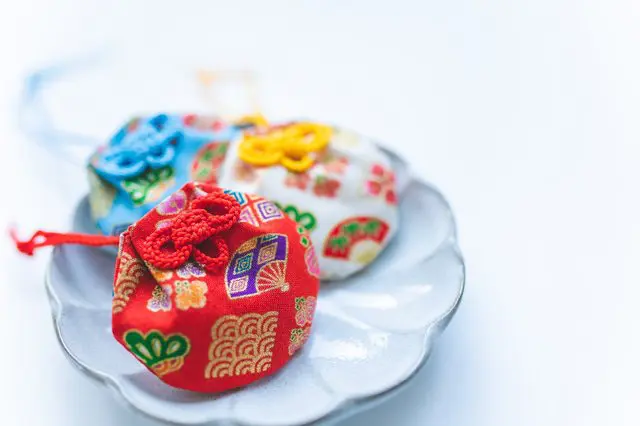The Basics Of Japanese Talismans, Courtesy Of Sensoji Temple

The types and varieties of talismans or lucky charms sold at temples and shrines across Japan is vast, but there are some important rules to keep in mind when purchasing and using them. Here is the information we learned from Sensoji Temple in Asakusa.

Avoid disaster or grant protection, there are a wide variety of divine charms called 'omamori' sold at various temples and shrines all across Japan. The handling of such a token--a symbol of a god’s divine power--must be done with special attention. Today, we will answer some questions about the correct way to handle and store charms, as well as how to dispose of them properly once their luck has expired.
Question 1: Can I hang multiple charms together on my phone or bag?

photo by pixta
The effects of charms change depending on the heart of the owner. It’s said that multiple charms, no matter where you put them, will not sway a god’s influence one way or the other. Virtuous gods won’t cancel out each other’s charms if they’re put together. Similarly, there’s no problem with Shinto charms being used with charms from other religions.
However, it is possible that a Buddhist charm may not work near a Shinto charm, so you will need to ask if it’s okay to keep it with a Shinto charm at the temple grounds when you buy it.
Question 2: How do I dispose of a charm correctly?

photo by pixta
Buying a charm is a good thing, so disposing of one shouldn’t be something bad or a hassle. When it’s time to dispose of a charm (usually one year after purchase or if it breaks), then you can take it to a shrine and ask them to dispose of it for free. In Sensoji there's a collection point with 'Accepting expired charms' written in Japanese (古札お納め所). Shrines will stay like this year-round to accept all good-luck items. For those living abroad, you can always try mailing the charms to the temples.
However, there is one thing you need to be careful of. The charm you bought from the god must be returned to that god; you need to take your charm to the same shrine you bought it from. Think of the charm as a part of that god. We must accept and return it with gratitude.
Question 3: What is the correct method of counting charms?

photo by pixta
So far we’ve talked about the correct way to take care of charms, but we haven’t yet addressed the way they are counted in Japanese. Since a charm contains the spirit and power of a god, we don’t just say “one or two” like we do for normal items. Instead, it’s counted as “one body or two bodies”, the same way you count Buddhist statues. So when you decide what to order, please say “I would like (insert number) + bodies”. In Japanese, this is (insert number) + tai.
However, in the case of other countries or languages, please just order as you normally would- there’s no need to worry about it.
Question 4: Can I open a charm to check what’s inside?

Charms, which are made to be carried around, are small brocade bags with materials such as wood, cloth, metal, paper, and the like inside (usually with sutras, a prayer, or left blank). A string is threaded through the mouth of a bag and it is sold in a closed state.
Source: Omamori net (Japanese)
Of course, looking at the shape and size of a charm will spark curiosity as to what’s hidden inside. However, looking at what’s within and verifying the charm is seen as “an act of an unbeliever” - meaning that the charm will no longer work, or may even cause bad luck instead. By believing in what your eyes cannot see, your faith is deepened.
FAQ
What is the talisman from the Japanese temple?
The talisman or amulet you would receive from a Japanese temple is typically called an "omamori." These are traditional Japanese lucky charms or amulets that are often sold at shrines and temples. Omamori are believed to provide various forms of protection or good luck to the holder, depending on the specific purpose of the amulet. They are usually small, colorfully decorated cloth pouches containing a sacred text or symbol associated with blessings, health, success, safe travel, or other positive outcomes. Visitors to shrines and temples in Japan often purchase omamori as souvenirs or for personal use in hopes of receiving divine protection or fortune.
How to pay respect at a Japanese shrine?
To pay respect at a Japanese shrine, follow a series of customary steps. Upon approaching the shrine, bow slightly upon passing through the torii gate. Next, purify yourself at the temizuya by rinsing your hands and mouth with water. Proceed to the offering box near the main hall, bow deeply, toss a coin into the box, clap your hands twice to get the deity's attention, and then bow once more. Take a moment for prayer, expressing wishes or gratitude silently or verbally. Before leaving, bow respectfully once again. Adhere to shrine rules, such as refraining from photography in certain areas or maintaining a quiet demeanor. By following these traditions, you can show proper reverence and conduct when visiting a Japanese shrine.
Can I keep omamori forever?
In Japanese tradition, omamori are generally intended to be kept for a specific period or until they are replaced. It is believed that omamori should be replaced annually (at the New Year in Japan) or when their intended purpose has been fulfilled, such as when a specific goal has been achieved or when the protection they offer is no longer needed. It is not considered appropriate to keep using the same omamori indefinitely. When replacing an omamori, the old one is typically returned to the shrine or temple where it was obtained for proper disposal or ritual burning. This practice is meant to show respect for the spiritual significance of the amulet and to signify the completion of its intended purpose.
Can you throw away omamori?
When it comes to disposing of omamori, which are traditional Japanese amulets or talismans, it's important to handle them with respect and care due to their sacred nature. Once an omamori has served its purpose, is damaged, or when it needs to be replaced, it is not appropriate to simply throw it away in the regular trash. Instead, the proper way to dispose of an omamori is to return it to the shrine or temple where it was obtained. Shrines and temples have designated areas for collecting old or expired omamori for ceremonial burning or other appropriate methods of disposal. By returning the omamori to the place of origin, you show reverence for its spiritual significance and ensure that it is disposed of in a respectful manner according to traditional customs.
What is the difference between omikuji and omamori?
In the realm of Japanese spiritual practices, omikuji and omamori serve distinct purposes. Omikuji are fortune-telling paper strips obtained at Shinto shrines or Buddhist temples, offering predictions varying from good luck to bad luck. These slips are often kept as charms or left at the shrine or temple. Omamori, on the other hand, are amulets or talismans acquired at shrines and temples with specific intentions of providing protection, luck, or blessings. They are used for purposes such as ensuring good health, success, safe travels, or academic achievements and are commonly carried or placed in designated areas like bags or homes. While omikuji offer glimpses into the future through luck-based fortunes, omamori are tangible items believed to offer protection and positivity, typically replaced annually or when their purpose is fulfilled.
Can you have two omamori?
In Japanese culture and tradition, it is acceptable to have more than one omamori at a time. People often carry multiple omamori to address different areas of their life where they seek protection or blessings. Each omamori is typically intended for a specific purpose, such as health, success, relationships, or studies. Having multiple omamori allows individuals to tailor their spiritual practices to various aspects of their lives or to address different needs simultaneously. However, it is important to treat each omamori with respect and follow the customs associated with their care and maintenance to ensure their effectiveness.
Where to hang omamori?
Omamori, traditional Japanese amulets believed to provide protection and blessings, can be hung or placed in various locations for maximum efficacy. Popular spots to hang omamori include bags or purses, keychains, home altars, bedrooms, offices, and cars. By keeping the amulet close in daily life, individuals seek continuous protection and positive energy. Placing omamori in personal spaces like bedrooms or work areas signifies a desire for blessings in those specific environments. Whether at home, work, or on the go, the careful and respectful placement of omamori is crucial to honor their spiritual significance and derive the intended benefits from these sacred talismans.
In Conclusion
Hopefully, everyone can now understand what they need to know about charms. There are many requirements that we must be careful of in order for the talisman to work effectively and to not offend the gods. Above all, the most important one is to always carry the charm with you. If you keep the charm with you at all times, then you can be under the god’s protection and part of his or her favour at any time you need it.
94年生まれ。神戸出身、東京在住。アメリカからの帰国子女。旅、アート、食が大好きな大学生。







































![[Coupon Available] Attention Overseas Winter Sports Fans! Nagano's Sports Depot Has Evolved](https://resources.matcha-jp.com/resize/720x2000/2026/01/05-254819.webp)
![[2 hours from Tokyo ] 10 Quiet and Breathtaking Views of Mount Fuji in Yamanashi Hokuto City , Yamanashi - Part 2](https://resources.matcha-jp.com/resize/720x2000/2025/12/16-253037.webp)

![[Reopening in March 2026] Ikoma Sanjo Amusement Park Park, 45 minutes from Osaka , with free admission](https://resources.matcha-jp.com/resize/720x2000/2024/08/28-194409.webp)